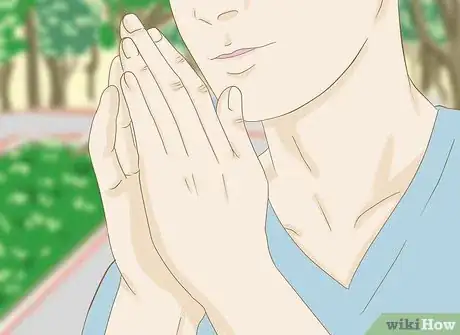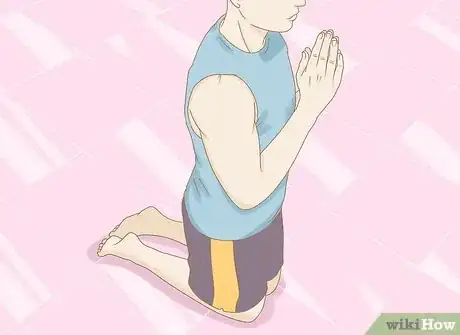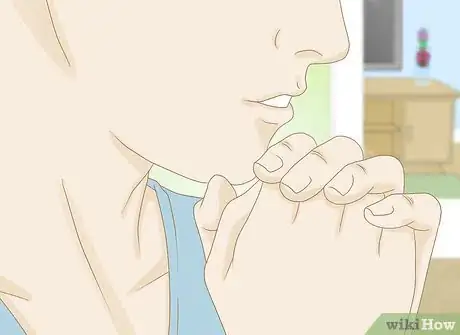X
wikiHow is a “wiki,” similar to Wikipedia, which means that many of our articles are co-written by multiple authors. To create this article, 11 people, some anonymous, worked to edit and improve it over time.
This article has been viewed 21,132 times.
Learn more...
Jains worship the images of four and twenty Tirthankaras (lit. "ford-makers") and siddha (infinite liberated beings). In Jainism, the purpose of prayer is to break the barriers of worldly attachments and desires and to assist in the liberation of the soul. Jains do not pray for any favors, material goods or rewards.[1] There are many Jain temples spread across India; to learn how to pray in one, start with step one, below.[2]
Steps
-
1Do darshana (seeing the image of the God). Along with the darshana, chant the most fundamental prayer, the Namokara Mantra nine times. The Namokara Mantra is dedicated to Pañca-Parameṣṭhi (Sanskrit for "five supreme beings"), a fivefold hierarchy of religious authorities worthy of veneration. The Namokara Mantra:[3]
- Ṇamō Arihantāṇaṁ- I bow to the Arihantas (Omniscient beings)
- Ṇamō Siddhāṇaṁ- I bow to the Siddhas (Liberated souls)
- Ṇamō Ayariyāṇaṁ- I bow to the Acharya S ("Preceptors")
- Ṇamō Uvajjhāyāṇaṁ- I bow to the Upadhyay (Preceptors of less advanced ascetics)
- Ṇamō Lōē Savva Sāhūṇaṁ- I bow to all the monks and nuns
-
2Worship the qualities of the God. The eight qualities of Siddhas are:[4]
- infinite faith or belief in the tattvas or essential principles of reality.
- infinite knowledge
- infinite perception
- infinite power
- fineness
- inter-penetrability-It means that the liberated soul does not hinder the existence of other such souls in the same space.
- agurulaghutva – literally, neither heavy nor light. Due to this quality of agurulaghutva, the jīva (soul) continues to manifest through its form, complete and perfect.
- infinite bliss
Advertisement -
3Say a prayer.
- "I bow to the Lord, the promulgator of the path to liberation, the destroyer of mountains (large heaps) of karmas and the knower of the whole of reality, so that I may realise these qualities."
- You can also say special prayers. For this, see the symbol below the image to identify the Tirthankara to whom the image is dedicated. For example, if the image is dedicated to Tirthankara Mahāvīra (symbol-lion), you may say the following verse:
-
Namāh śri Vardhamāna-e nirdhutakalilātmane
Sālokānāma trilokānāma yadā-vidyā darpanāyate!
Tr.- I bow to Śri Vardhamāna Mahāvīra who has washed off the impurities of karmic filth from His Soul, [and]
In Whose Perception scintillate the three Worlds and the infinity of Space, as in a mirror.
-
Namāh śri Vardhamāna-e nirdhutakalilātmane
-
4Follow up your prayer. After darshana, you can sit and do meditation. You can also use a rosary (present in all Jain temples) to chant the sacred mantra, the Namokara Mantra.
Advertisement
Community Q&A
-
QuestionCan someone give me the step by step details of the prayers before leaving the house and going to temple?
 Community AnswerFirst address the God you are going to pray to, by name if you know it. Second, give thanks for previous answers to prayers, and even "gifts" you did not pray for, but received. Then ask your "favor" if you were planning to pray for some item, such as Healing, forgiveness, other need, or even if you are asking some thing for a friend. Then close it out by again thanking for the answer to your prayer.
Community AnswerFirst address the God you are going to pray to, by name if you know it. Second, give thanks for previous answers to prayers, and even "gifts" you did not pray for, but received. Then ask your "favor" if you were planning to pray for some item, such as Healing, forgiveness, other need, or even if you are asking some thing for a friend. Then close it out by again thanking for the answer to your prayer.
Advertisement
Warnings
- Don't forget to remove any footwear before entering the temple. Most temples will have a space designated for the same. Unlike Hindu temples, socks should also be removed.⧼thumbs_response⧽
Advertisement
References
- ↑ Jainism article on Wikipedia
- ↑ List of famous Jain temples
- ↑ Namokar Mantra
- ↑ Jain, Vijay K (2014-03-26). Acharya Pujyapada's Istopadesa – the Golden Discourse. p. 5. ISBN 9788190363969.
About This Article
Advertisement

























































